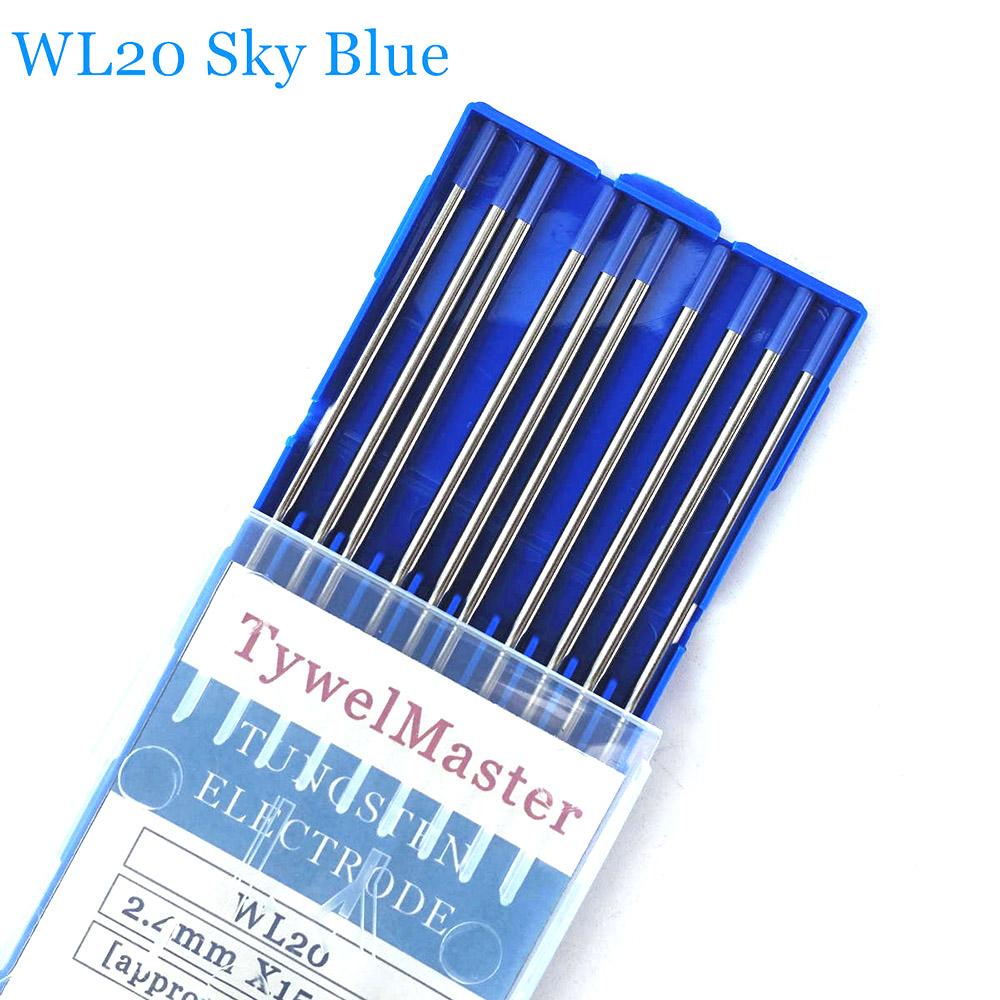It is our high quality product series, it is annealed and ground finished, it is no quality difference to the European products.
Introduction:
WT20:
2% thoriated tungsten electrodes (AWS classification EWTh-2) contain a minimum of 97.30% tungsten and 1.70 to 2.20% thorium. They are the most commonly used electrodes today and are preferred for their longevity and ease of use. Thorium increases the electron emission qualities of the electrode, which improves arc starts and allows for a higher current carrying capacity. This electrode operates far below its melting temperature, which results in a considerably lower rate of consumption and eliminates arc wandering for greater stability. It also features a lower level of weld contamination than other electrodes. Unlike pure tungsten, these electrodes are only for specialty type AC welding (thin gauge aluminum or materials less than .060-in.), but they are exceptional for DC electrode negative or straight polarity on carbon and stainless steel, nickel and titanium applications. During manufacturing, thorium is evenly dispersed throughout the electrode. This evenness allows the electrode to maintain a sharpened edge—the ideal electrode shape for welding thin steel. Sharpening the electrode’s point, however, should be done with great care.
WL20:
2.00% lanthanated tungsten electrodes (AWS classification EWLa-2.0) have excellent arc starting, low-burn-off rate, good arc stability and excellent re-ignition characteristics—many of the same advantages as ceriated electrodes. 2.0% lanthanated electrodes also closely resemble the conductivity characteristics of 2% thoriated tungsten, meaning, in some cases, it can replace 2% thoriated without having to make significant welding program changes. 1.5% lanthanated tungsten electrodes are ideal if you want to optimize your welding capabilities. Lanthanated electrodes work well on AC or DC electrode negative with a pointed end or they can be balled for use with AC sine wave power sources. The lanthana is dispersed evenly throughout the entire length of the electrode during manufacturing. It also maintains a sharpened point well, which is an advantage for welding steel and stainless steel on DC or the AC from squarewave power sources. Unlike thoriated tungsten, these electrodes are suitable for AC welding and, like ceriated electrodes, allow for the arc to be started and maintained at lower voltages. AC Compared to pure tungsten, the addition of 2.0% lanthana increases the maximum carrying capacity by approximately 50% for a given size electrode.
WL15:
1.5% lanthanated tungsten electrodes (AWS classification EWLa-1.5) have excellent arc starting, low-burn-off rate, good arc stability and excellent re-ignition characteristics—many of the same advantages as ceriated electrodes. 1.5% lanthanated electrodes also closely resemble the conductivity characteristics of 2% thoriated tungsten, meaning, in some cases, it can replace 2% thoriated without having to make significant welding program changes. 1.5% lanthanated tungsten electrodes are ideal if you want to optimize your welding capabilities. Lanthanated electrodes work well on AC or DC electrode negative with a pointed end or they can be balled for use with AC sine wave power sources. The lanthana is dispersed evenly throughout the entire length of the electrode during manufacturing. It also maintains a sharpened point well, which is an advantage for welding steel and stainless steel on DC or the AC from squarewave power sources. Unlike thoriated tungsten, these electrodes are suitable for AC welding and, like ceriated electrodes, allow for the arc to be started and maintained at lower voltages. AC Compared to pure tungsten, the addition of 1.5% lanthana increases the maximum carrying capacity by approximately 50% for a given size electrode.
WZ8:
Zirconiated tungsten electrode is the most commonly used in alternating current welding,which contains a small amount of Zirconium oxide. It’s electron work is 2.5eV-3.0eV. Zirconiated tungsten electron performs well, and it is easier to start arc than pure tungsten. Arc stability. It can also prevent and control pollution well. Current-carrying capacity is quite good as well. The biggest characteristic of this electron is that its top can keep globular to reduce the seepage of tungsten in the high load current and it also has good corrosion resistance. The superior performance of zirconiated tungsten electron cannot be replaced by other electron.
A Zirconiated tungsten electrode produces an extremely stable arc and resists tungsten spitting. It is ideal for AC welding as it retains a balled tip and has a high resistance to contamination. Its current carrying capability is equal to or greater than thoriated tungsten. Under no circumstances is zirconiated recommended for DC welding.
WR20: (called E3 in some country.)
Compound tungsten electrode is also known as three elements of rare earth. It is a non-radiation material. It is good to balance the electron mobility and evaporation rates, making tungsten electrodes to maximize their performances. For compound tungsten electrode, it’s easy to start and restart arc. If the welding cycle more than 15 minutes, its life will be last longer.
WR20 tungsten electrode tip burning significantly better than other tungsten electrodes. As three kinds of doping the oxide mixture in the electrode. It’s strict with the production process and the cost of production is more expensive.
Mix Type includes:
1pcs 1.0mm(1/25")
4pcs 1.6mm(1/16")
1pcs 2.0mm(2/25")
4pcs 2.4mm(3/32")
Package includes following:
10pcs a Pack, Please choose the size you need;







































